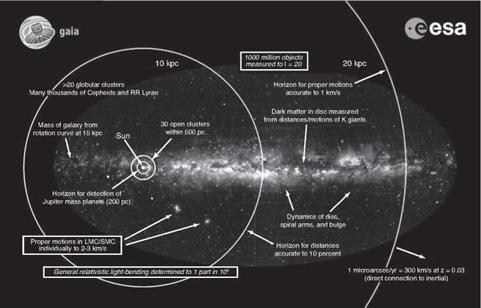Passing the Baton to Gaia
In a sense, not much has changed since ancient humans first looked toward the skies. Astronomers today are equally compelled to interpret the patterns in the stars within our galaxy and beyond. In late 2013, ESA plans to launch its next astrometry mission with the Gaia spacecraft (Global Astrometric Interferometer for Astrophysics), which will expand the work of Hipparcos.54 The Gaia mission, however, will be far more extensive and accurate in its survey of stars, taking in data on a thousand million stars in the Milky Way, charting the position, distance, brightness, and movement of each one (figure 8.5). It will achieve this by using much larger mirrors than Hipparcos and much more sensitive CCD detectors. Its goal is a precision of 20 micro-arcseconds for stars at magnitude 15, or 10,000 times fainter than the eye can see, and 200 micro – arcseconds for stars at magnitude 20, or a million times fainter than the eye can see. To extend an earlier analogy, the smaller of these tiny angles would be formed by drawing lines from the top and bottom of Lincoln’s eye on a penny in New York and having them come to an apex not in Paris but on the surface of the Moon!
It is anticipated that Gaia will measure and characterize several thousand exoplanets, detecting them by the subtle motion they induce in their parent star. Among these distant worlds, some that are Earth-like must surely exist. However, Gaia’s primary mission will be to produce an extraordinarily precise three-dimensional
|
Figure 8.5. The protean work of measuring the distances to stars facilitates a wide range of astronomy projects. Where Hipparcos reached several million stars, ESA’s Gaia mission will reach and measure nearly a billion, enabling everything from a local test of general relativity to a better understanding of the archaeology of the Milky Way (ESA/Gaia). |
map of the Milky Way galaxy and sharpen the crispness of our 3D view.55 As explained on the Gaia website, “In the process, Gaia will also map the motions of stars, which encode their origin and subsequent evolution. Through comprehensive photometric classification, Gaia will provide the detailed physical properties of each of the billion stars observed.” Such information will include data on luminosity, temperature, gravity, and elemental composition, which can be used to unravel information on the origin, structure, and evolution of our galaxy. “Gaia’s expected scientific harvest is of almost inconceivable extent and implication. . . . Amongst other results relevant to fundamental physics, Gaia will follow the bending of star light by the Sun, over the entire celestial sphere, and therefore directly observe the structure of space-time.” As a means of comparison with its predecessor, Gaia planners note: “The 16 volumes of Hipparcos would instead be 160,000 volumes and instead of filling one normal bookshelf, that bookshelf would have to stretch the equivalent distance of Paris to Amsterdam.”56
Perhaps most important, Gaia will dramatically alter our sense of humankind’s place in the Milky Way and in the universe. Far exceeding the Apollo 8 image of “Earthrise from the Moon,” or the Apollo 17 image of the “Whole Earth,” the Gaia mission has the potential to entirely overhaul our thinking about our grain of sand, the Earth, in the chasm of interstellar space. Astronomers have already discussed the extent to which the mission will powerfully impact nonspecialist audiences. In the coming decade, our children will have the opportunity to see in exquisite detail where we are in relation to our nearest star neighbors as educators plan virtual astronomy courses for educational institutions and planetaria. Based on new and rich data from Gaia, virtual flights into a 3D version of a larger portion of the Milky Way galaxy are just one of the expected educational outcomes.57 With Gaia, and the virtual galaxy its data will help build, the scientific and public understanding regarding our place in the Milky Way is poised to be radically reconfigured.
Roughly half the world’s population live in urban areas. Light pollution inherent to cities means that 50 percent of humankind has to a large extent lost access to, and knowledge built upon, the night sky. However, scientific missions like Hipparcos and Gaia are restoring our relationship to the stars and generating remarkable new knowledge regarding Earth’s place in our galaxy. Hipparcos has already rewritten the narratives we will tell our children about the past and present morphology of the Milky Way and the exoplanets we are currently finding orbiting nearby stars. What Gaia promises to contribute will rewrite the textbooks again. The story of our galaxy that we hand on to future generations will disclose the number and locations of many other worlds like ours and will inevitably be vital to the human narrative of future ages.











